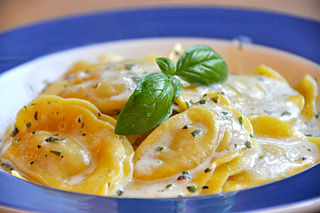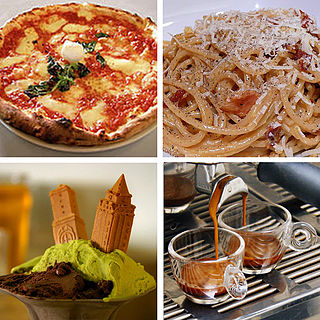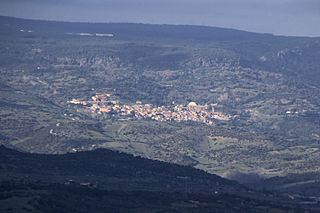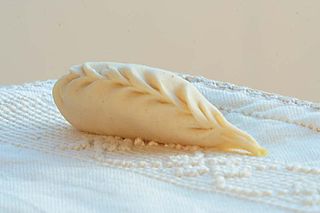
Pasta is a type of food typically made from an unleavened dough of wheat flour mixed with water or eggs, and formed into sheets or other shapes, then cooked by boiling or baking. Pasta was traditionally only made with durum, although the definition has been expanded to include alternatives for a gluten-free diet, such as rice flour, or legumes such as beans or lentils. While Asian noodles are believed to have originated in China, pasta is believed to have independently originated in Italy and is a staple food of Italian cuisine, with evidence of Etruscans making pasta as early as 400 BCE in Italy.

Tomato sauce can refer to many different sauces made primarily from tomatoes, usually to be served as part of a dish, rather than as a condiment. Tomato sauces are common for meat and vegetables, but they are perhaps best known as bases for sauces for Mexican salsas and Italian pasta dishes. Tomatoes have a rich flavor, high water content, soft flesh which breaks down easily, and the right composition to thicken into a sauce when stewed, without the need for thickeners such as roux or masa. All of these qualities make them ideal for simple and appealing sauces.

Gnocchi are a varied family of dumpling in Italian cuisine. They are made of small lumps of dough, such as those composed of a simple combination of wheat flour, potato, egg, and salt. Variations of the dish supplement the simple recipe with flavour additives, such as semolina flour, cheese, breadcrumbs, cornmeal or similar ingredients, and possibly including herbs, vegetables, and other ingredients. Base ingredients may be substituted with alternatives such as sweet potatoes for potatoes or rice flour for wheat flour. Such variations are often considered to be non-traditional.

Lasagna is a type of pasta, possibly one of the oldest types, made of very wide, flat sheets. Either term can refer to an Italian dish made of stacked layers of lasagna alternating with fillings such as ragù, béchamel sauce, vegetables, cheeses, and seasonings and spices. The dish may be topped with grated cheese, which becomes melted during baking. Typically cooked pasta is assembled with the other ingredients and then baked in an oven. The resulting baked pasta is cut into single-serving square or rectangular portions.

Ravioli are a type of stuffed pasta comprising a filling enveloped in thin pasta dough. Usually served in broth or with a sauce, they originated as a traditional food in Italian cuisine. Ravioli are commonly square, though other forms are also used, including circular and semi-circular (mezzelune).

Penne alla vodka is a pasta dish made primarily with vodka and penne, usually accompanied with heavy cream, crushed tomatoes or tomato sauce, onions, and sometimes small meats and vegetables like sausage, pancetta or peas. The alcohol apparently helps intensify and accentuate flavors in the dish, among other claims.

Linguine is a type of Italian pasta similar to fettuccine and trenette, but elliptical in section rather than flat. It is about 4 millimetres in width, which is wider than spaghetti, but not as wide as fettuccine. The name linguine means 'little tongues' in Italian. Linguine was traditionally served with sauces such as pesto, but others such as tomato or fish based sauces are popular as well. Linguine originated in Italy and is based on more traditional pastas. It is a type of pasta that finds its origin in Genoa. Linguine is typically available in both white flour and whole-wheat versions, but was originally made with durum wheat. In the United States, National Linguine Day occurs on September 15 every year.

In Italian cuisine, ragù is a meat sauce that is commonly served with pasta. An Italian gastronomic society, Accademia Italiana della Cucina, documented several ragù recipes. The recipes' common characteristics are the presence of meat and the fact that all are sauces for pasta. The most typical is ragù alla bolognese. Other types are ragù alla napoletana, ragù alla barese, ragù alla veneta, and so on.

Rigatoni con la pajata is a classic dish of the Roman cuisine. It can be found in some traditional trattorias in Rome.

Italian cuisine is a Mediterranean cuisine consisting of the ingredients, recipes and cooking techniques developed in Italy since Roman times and later spread around the world together with waves of Italian diaspora. Some of these foods were imported from other cultures. Significant changes occurred with the colonization of the Americas and the introduction of potatoes, tomatoes, capsicums, maize and sugar beet—the latter introduced in quantity in the 18th century. It is one of the best-known and most appreciated gastronomies worldwide.

Pasta e fagioli is a traditional Italian pasta soup of which there are several regional variants.

Morgongiori is a comune (municipality) in the Province of Oristano in the Italian region Sardinia, located about 70 kilometres (43 mi) northwest of Cagliari and about 25 kilometres (16 mi) southeast of Oristano on the southern slopes of Monte Arci.

Neapolitan cuisine has ancient historical roots that date back to the Greco-Roman period, which was enriched over the centuries by the influence of the different cultures that controlled Naples and its kingdoms, such as that of Aragon and France.

The cuisine of Sardinia is the traditional cuisine of the island of Sardinia, and the expression of its culinary art. It is characterised by its own variety, and by the fact of having been enriched through a number of interactions with the other Mediterranean cultures while retaining its own identity. Sardinia's food culture is strictly divided into food from the land and food from the sea, reflecting the island's historical vicissitudes and especially its geographic landscapes, spacing from the coastline to the ragged mountains of the interior. The Sardinian cuisine is considered part of the Mediterranean diet, a nutritional model that was proclaimed by UNESCO as an intangible cultural heritage.
Filindeu is a rare type of pasta from the Barbagia region of Sardinia. It is made by pulling and folding semolina dough into very thin threads, which are laid in three layers on a tray called a fundu and dried to form textile-like sheets. The dried sheets are then broken into pieces and served in a mutton broth with pecorino sardo cheese. Filindeu is listed on the Ark of Taste.

Tumact me tulez is a pasta dish from southern Italy, specifically Basilicata, of Arbëreshe origin. The name means 'tagliatelle with breadcrumbs'.

Malloreddus, sometimes Italianized as gnocchetti sardi, are a type of pasta typical of Sardinian cuisine. They have the shape of thin ribbed shells, about 2 cm (0.79 in) long, and are made of semolina flour and water. They are usually eaten with different sauces

Culurgiones are a type of Sardinian ravioli-like stuffed pasta. It exists in a version made of potatoes, pecorino cheese and mint, a typical culinary specialty of the sub-region of Ogliastra, and in several other recipes adopted in the rest of the island, such as in Gallura, where the product is aromatized with lemon or orange peel.
















